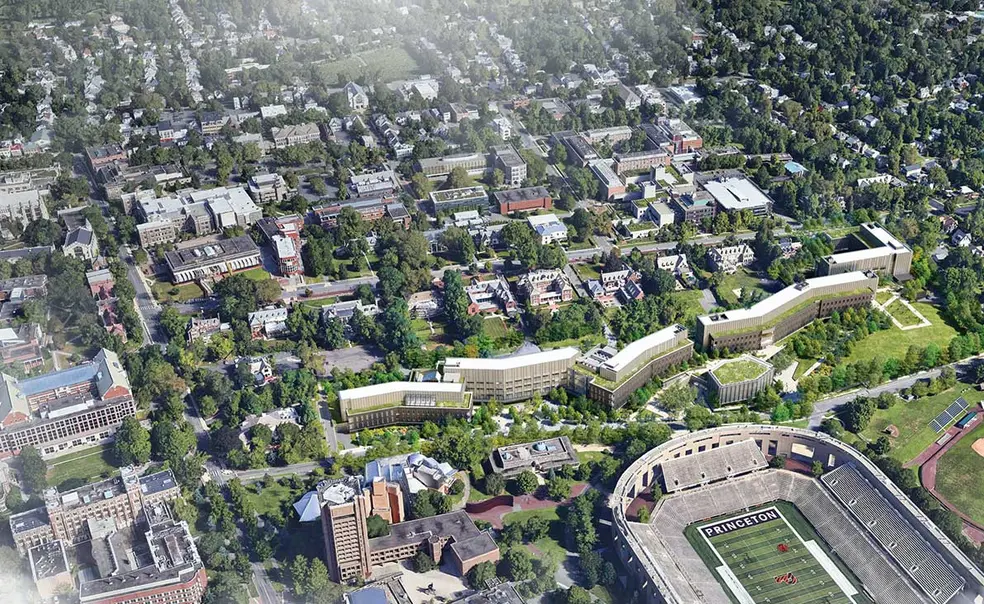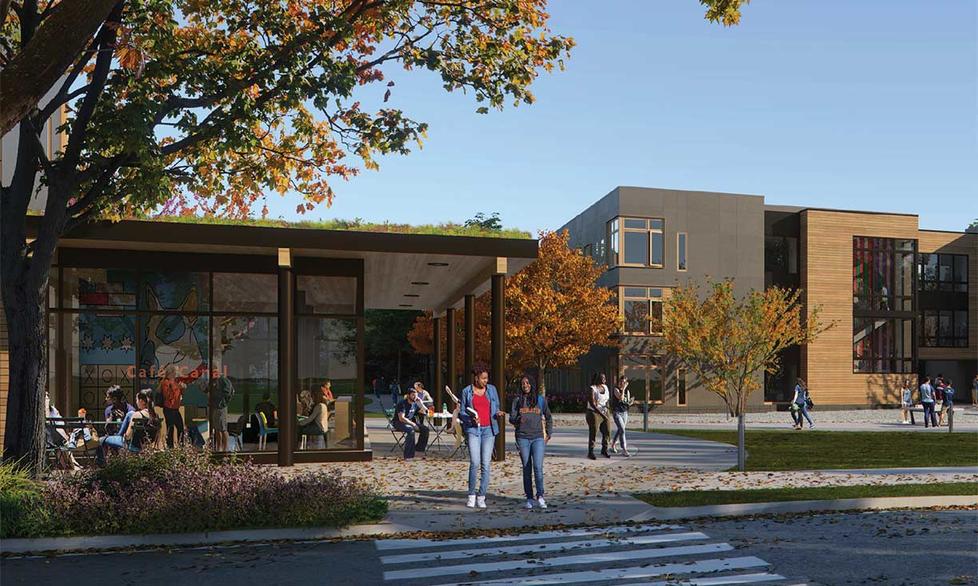Building Boom Adding Space for Sciences, Engineering, and More
“This does become a draw for our goal to bring the best in the world to Princeton,” said geosciences professor Gabriel Vecchi
Nearly a mile of chain-link fencing surrounds the construction site for Princeton’s new Environmental Studies and School of Engineering and Applied Science complex (ES & SEAS). You can catch glimpses of the excavation between the eating clubs on Prospect Avenue or find a clearer view from the rerouted sidewalk along Ivy Lane. Occasionally, the project may even shake the ground beneath your feet — the geosciences department’s broadband seismometers in Guyot Hall routinely record construction activity from campus sites.
“Every two weeks or so, I make a point of taking a break for half an hour and walking around the perimeter to see what has happened,” said Professor Athanassios Panagiotopoulos, chair of chemical and biological engineering, one of the departments that will be housed in the complex. “They’re making impressive progress.”
Scheduled for completion in the spring of 2025, the ES & SEAS complex will eclipse the E-Quad as the largest set of facilities Princeton has ever built at once, according to University Architect Ron McCoy *80. The project will provide cutting-edge labs for research ranging from carbon mitigation to drug development. In addition to engineering, the neighborhood will include Princeton’s High Meadows Environmental Institute (HMEI), the departments of ecology and evolutionary biology and geosciences, and spaces meant to foster interdisciplinary relationships, all linked below ground. McCoy said this “shirtsleeve connection” — the opportunity to visit or just bump into colleagues without putting on a jacket and going outside — was a key element of the project’s design.
HMEI is inherently interdisciplinary, since all faculty are cross-appointed with academic departments, and director Gabriel Vecchi, a professor of geosciences, views the complex as a clear illustration of the University’s commitment to environmental research. “Prospective faculty, graduate students, and early-career researchers see these plans and are very excited by them,” Vecchi said. “This does become a draw for our goal to bring the best in the world to Princeton.”
ES & SEAS is one of a half-dozen significant construction sites on campus. Two residential colleges, New College East and West, are nearing completion south of Poe Field. The new Princeton University Art Museum is being built on the site of its former home. East of Jadwin Gym, a reconfigured Roberts Stadium is taking shape next to the Stadium Drive Garage, set to open this summer. A facility on the other side of Fitzrandolph Road will manage the University’s geo-exchange energy system (see PAW, April 2022). And across Lake Carnegie, housing for graduate students and postdoctoral researchers is being built as part of the Lake Campus project.
President Eisgruber ’83, in his annual letter to the University community, called this “one of the most intense periods of growth and building in Princeton’s history,” and McCoy has the stats to back it up: In terms of square footage added, he said, the current generation of projects will top the University’s great expansion in the 1960s (though that growth was proportionally larger, since the campus was smaller at the time).
At Princeton, “there’s never been anything like what we’re doing right now,” McCoy said, citing the number of strategic initiatives addressed by the construction — the growth of the undergraduate student population, investments in research, the addition of athletics and fitness facilities, and “the leap across the lake.” More projects are in the pipeline, including the conversion of Guyot Hall into Schmidt Hall, which will bring computer science to a more central location; an expansion of recreational space at Dillon Gym; new facilities for University Health Services; and the construction of Hobson College, which will take the place of First College (formerly Wilson).
Take a Closer Look:
RESIDENTIAL COLLEGES (2022)
New College East and New College West, situated around a shared courtyard, will open in the fall semester, and McCoy looks forward to seeing students using the new social, community, and dining spaces. “It’s really a small village that is made up of those two colleges,” he said. McCoy is also looking ahead to the construction of Hobson College, targeted to open in 2026, which will be situated around a new campus passageway (tentatively called the east-west connector) that links the Graduate College and other student residences with the new facilities along Ivy Lane.
LAKE CAMPUS (2023–24)
In the University’s new system of maps and kiosks, the Lake Campus will be part of what is called the Meadows neighborhood, a name chosen to reflect a landscape that features vistas distinctly different from those seen on the historical campus. The graduate housing will be built to Passive House energy-conservation standards, McCoy said, which means that “less heat is escaping during the winter and less heat is penetrating into the buildings during the summer.” The project also will include a racquet center for the tennis and squash teams, a varsity softball field, and the Haaga House, a field house for men’s and women’s rugby.
ART MUSEUM (2024)
By the time alumni arrive on campus for Reunions this month, part of the museum’s steel structure should be visible, and one primary space, the north-south art walk, will be taking shape, according to McCoy, who added that the museum “will be connected to the surrounding campus in really dramatic ways.” The design was led by architect Sir David Adjaye, best known for designing the Smithsonian National Museum of African American History and Culture in Washington, D.C.
ES & SEAS (2025)
Princeton’s facilities for environmental research will represent “an acceleration of the commitment to sustainability” in design and architecture, McCoy said. The plans for ES & SEAS include some of the first buildings on campus to use mass timber, compressed layers of wood that reduce “embodied carbon,” the carbon emissions involved in producing building materials. The hillside site also will use green construction to manage stormwater.












2 Responses
Rocky Semmes ’79
3 Years AgoEnvironmentalism and Habitat Loss
Global wildlife numbers, across nearly every extant species, are recorded over the last 50 years as dropping markedly, so there is both irony and also cause for celebration in construction of ES & SEAS, the new sprawling complex of facilities for environmental research (On the Campus, May issue). The scientific counts for mammal, avian, insect, reptile, amphibious, and ocean species are crashing and plummeting, in many instances by 50 percent or more, and the single largest threat to each (reliably) is habitat loss.
The reported “acceleration of the commitment to sustainability” of the project, described by University Architect Ron McCoy *80, is laudable but perhaps laughable as well as one begins to wonder if what we are doing is already a day late and a dollar short. But you do what you have to do, and the laughter is good, holding off what might otherwise become crying.
Murphy Sewall ’64
3 Years AgoSeems a Bit Overwhelming
On the one hand, I’d love to be 18 and matriculating to undertake STEM education in today’s world. On the other, it looks like, even for an 18-year-old, getting around to all the places on campus and in town that an undergraduate wants to routinely go to will require something more capable than the simple three-speed bike that did the job in the 1960s — an electric bike perhaps?
I discovered at my last reunion in 2019 that it was a mistake not to prearrange the regular services of a golf cart. I did not notice the differences in elevation from one spot on campus to another when I was an undergraduate, but at my present age getting about seems to constantly require walking uphill — something I find I am even less able to accomplish today.